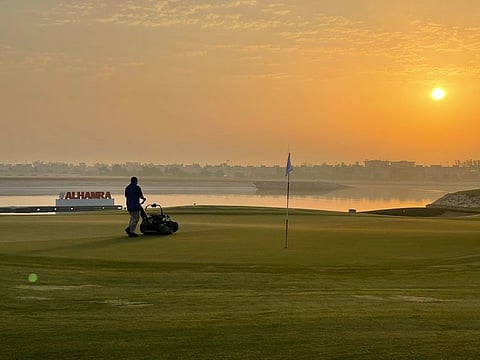Why do golf courses need a “Summer Renovation” in the UAE?
Scarification, Aeration, Amendment & Top Dressing are all in the renovation process

With golf participation having boomed in the Middle East by 223% since 2012, there are now over 42,000 golfers playing the game, with 21,000 of those being specifically in the United Arab Emirates.
It’s safe to say that with that there is a fair amount of wear and tear on the 31 courses across the UAE which are made up of a mixture of 9 & 18 hole courses.
Maintaining them is a 24/7 job, and adding to that, each golf courses agronomy team have to find time to get further renovations done so then the courses are in the best conditions possible for the longest period of time throughout the year.
When better to complete those much needed renovations than in the summer, when the courses have the least amount of traffic on them.
But what is a summer renovation?
Renovations are done so then the golf courses are given a chance to recover from the year-round pressure of general golf shots, machinery and golf buggies all which are putting physical pressure on the grass which is then being compacted resulting in creating thatch.
It may not look pretty and be partly disrupting to putt on but in the long run it will overall benefit the turf and only last a couple of weeks.
On the greens specifically there will be four main renovations completed:
- Aggressive scarification
- Aeration or compaction relief treatment at greater depth
- Amendment applications
- Top dressing
It may not look pretty and be partly disrupting to play on, but in the long run it will overall benefit the turf and only last a couple of weeks.
What is thatch?
Thatch is formed between the layer of grass and the soil which makes it tricky for the water and nutrients to reach the soil. Therefore the grass will become week as the roots aren’t able to grow deep into the soil due to thatch.
How is thatch removed?
There are 3 steps to removing thatch. Scarification & Coring, Amendment application, and Topdressing.
Scarification is carried out with a powerful scarifier, drives sharp blades just into the thatch. As well as removing thatch, scarification also provides an element of aeration, and will also reduce sponginess.
Coring allows the compacted turf to expand and air and moisture to be more easily absorbed. thatch. Coring also removes accumulated fiber in the grass root zone. It allows for the exchange of a poor soil for a better one through top dressing. That’s why the greens are normally covered in sandy top dressing immediately after they’re cored.
In the amendment application Gyspum is used to reduce soil compaction and improves soil structure. It increases air movement and prevent reduce water run-off.
Granular seaweed is also applied to improve the structure of the soil in helping the moisture and nutrient retention.
And finally, topdressing is then to be done. A layer of sand is applied into the grass to help with level, firmness and root development.
There are various positives to these renovations to being completed. In the long-term it helps with encouraging new growth, increase air and light circulation and minimize fungal disease to name just a few. But most importantly, it will benefit all golfers playing experience throughout their next golfing year.
Sign up for the Daily Briefing
Get the latest news and updates straight to your inbox



